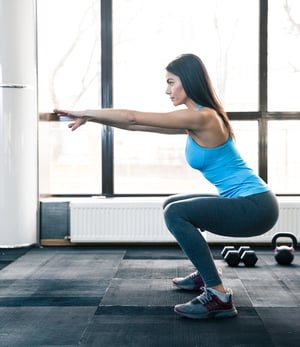 Your butt might be dead. Yes…that’s correct. Gluteal amnesia or dead butt syndrome is a real condition in which the gluteal muscles stop firing correctly. Recent research suggests that the majority of Americans can spend up to 15 hours a day sitting. This is associated with some major health problems as well as an overall shorter life expectancy. But, your glutes are responsible for so much more than just sitting.
Your butt might be dead. Yes…that’s correct. Gluteal amnesia or dead butt syndrome is a real condition in which the gluteal muscles stop firing correctly. Recent research suggests that the majority of Americans can spend up to 15 hours a day sitting. This is associated with some major health problems as well as an overall shorter life expectancy. But, your glutes are responsible for so much more than just sitting.
Your glutes play a key role in just about everything you do (think sitting, standing, bending, stabilization, balance) and are an important muscle group for many reasons, including injury prevention, improving performance, and helping you look good in your clothes. When your glutes are lacking in strength, your body will let you know. Below are some common problems that may be the result of weak glutes as well as some exercises to help wake them back up.
Low Back Pain
When our bodies are called on to perform a function such as bending or squatting, our brains determine which muscles are needed. If one muscle group isn’t up to the task, your brain will get another group to do the brunt of the work. If you’re trying to pick an object up off the floor and your glutes can’t perform the task, oftentimes the lower back is called upon to pick up the slack. Over time, the added stress builds up and may lead to soreness, pain, muscle spasms, or injury. As if that weren’t enough, research backs this up: A study published in the journal PLOS One found that middle-aged women with chronic low back pain had much smaller butt muscles than their pain-free friends.
Knee Pain
The glutes are responsible for stabilizing the knees as you walk, stand, run, squat, and lunge. If the musculature above the knee isn’t there, the knees become unstable, and that’s when pain can start to occur.
Balance Problems
The glutes provide a stable space from which your arms and legs can move. When the glute muscles aren’t strong enough to support that base, the limbs can become weak and unstable as well.
Poor Performance and Durability
The glutes are a thick, fibrous muscle group and play a role in generating power. When the muscles are weak, the glutes cannot generate force efficiently, leading to a decreased ability to run, walk up stairs, return a volley in racquetball or squash, and a decline in stamina.
So, how do you “wake up” your butt and get the glutes to fire correctly? Try some of the exercises below:
Modified Clamshell
Clamshells build strength in the gluteus medias (side glutes) and help stabilize the pelvis
- Lie on your side and rest your head comfortably.
- Bottom leg should be straight. Top hip bent up to ninety degrees with top foot resting behind bottom knee. Hips should be forward and remain in forward position throughout the entire movement.
- Squeeze glutes and lift knee off the ground, keeping top foot rested on bottom knee. Keep hips forward.
Body Weight Squat
Squats strengthen glutes, abdominals, and all the big muscles in the legs, including quads and hamstrings
- Stand with feet about hip width apart. Hold arms straight out in front and brace abdominals.
- Push hips back, bend knees, and lower body into a squat while squeezing knees out towards baby toes.
- Pause at the bottom of the squat for two seconds and then come back to a standing position, squeezing the glutes on the way up.
Glute Bridge with March
Bridges activate the entire posterior chain of the body. The basic bridge is very simple: lay on back with feet flat on the floor, knees bent. Lift hips up in the air. Adding the march forces you to engage all your stabilizer muscles.
- Get into bridge position and lift your hips in the air.
- At the top position, without allowing any movement through the hips, slowly lift one leg off the ground and hold for two seconds.
- Put the leg down and lift the opposite leg.
Slider Reverse Lunge
The slider reverse lunge is simple to perform and isolates and engages the glutes
- Grab a slider or similar tool that will allow you to move easily across the ground.
- Put the slider under one foot and use that foot to slide into a reverse lunge, and then return to standing.
- Do all reps on one side and then change legs.
Do all exercises several times a week, 10 reps, switch legs (if needed), then repeat. Watch how everything improves once your glutes are activated and return to life.
Sources:
https://www.silversneakers.com
https://breakingmuscle.com/fitness
http://www.stopchasingpain.com










